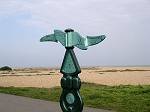Walmer's Past
A Brief History of Walmer
Although most people would consider the Walmer of today a relatively quiet mainly residential seaside town, it certainly had a turbulent past.
Julius Caesar and his legions are said to have first landed on Walmer beach in 55BC.
The ruins around old St. Mary's Church in Upper Walmer are those of the former manor house which originally belonged to the Auberville family who came with the Norman Conquest. A yew tree in the churchyard is thought to be 1,000 years old.
Walmer's development over the years owes much to the one-time importance of neighbouring Deal as a sea port. Thanks to its location facing "The Downs" - a stretch of water between the shore and the treacherous Goodwin Sands - Deal thrived as a safe anchorage for sailing ships from the 1400s to the 1800s. The introduction of steam powered vessels greatly reduced the need to wait for favourable winds and tides and Deal, faced with a declining demand for servicing shipping, turned to tourism and attracting holiday visitors, helped by the arrival of the railway in 1847.
The earlier strategic importance of "The Downs" is underlined by the decision of Henry VIII to order the building of the 'Three Castles which keep The Downs' - Deal, Walmer and Sandown - in 1540. The King's quarrel with the Pope made him fearful of invasion. In the English Civil War, the castles were taken by Cromwell within 13 days.
Today, Walmer Castle and its beautiful formal gardens are a major attraction for visitors. The official residence of Lord Warden of the Cinque Ports since the 18th Century, the building is now an English Heritage property and features a collection of memorabilia of the Duke of Wellington, of Battle of Waterloo fame, who made Walmer his home for 23 years.
Walmer Barracks were built in 1794 and a Royal Naval Hospital added in 1800-12. These buildings later housed the Royal Marines School of Music and, following its closure, were converted to private housing in 2003-2004.

